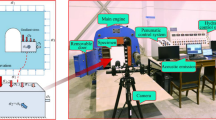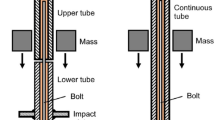Abstract
The performance of a structurally dissipating rock-shed (SDR) depends largely on the capacity of its energy dissipators. At present, most energy dissipators are made of metals, which dissipate energy by unrecoverable plastic deformation. Therefore, they are not able to recover their energy-dissipation capacity after deformation under rockfall impact. However, a rockfall usually disintegrates into pieces when it rolls down from a higher position and results in multiple rockfall impacts. An energy dissipator with self-recovery capability is therefore more suitable for ensuring the safety of SDRs. Replacing metal with polyurethane (a hyperelastic material with remarkable self-recovery capability) can provide self-recovery capability for energy dissipators, making them more suitable for resisting multiple rockfall impacts. In this work, polyurethane was manufactured into two types of energy dissipators: cylindrical and cubical. Full-scale falling rock impact tests and dynamic numerical simulations were conducted to study the mechanical response of the energy dissipators. In addition, in order to ensure the accuracy of the simulation, the dynamic mechanical properties of the polyurethane were tested and its dynamic constitutive model was established. The experimental and simulation tests have clarified the advantages of the polyurethane energy dissipator. We also summarized the practical considerations in the design of energy dissipators.
Similar content being viewed by others
References
Burke M, Woytowitz P, Reggi G (1992) Nonlinear viscoelastic constitutive model for solid propellant. J Propuls Power 8(3): 586–591. https://doi.org/10.2514/3.23518
Delhomme F, Mommessin M, Mougin JP, et al. (2005) Behavior of a structurally dissipating rock-shed: experimental analysis and study of punching effects. Int J Solids Struct 42(14): 4204–4219. https://doi.org/10.1016/j.ijsolstr.2004.12.008
Delhomme F, Mommessin M, Mougin JP, et al. (2007) Simulation of a block impacting a reinforced concrete slab with a finite element model and a mass-spring system. Eng Struct 29(11):2844–2852. https://doi.org/10.1016/j.engstruct.2007.01.017
Danilo DG, Luigi G, Capriello G, et al. (2020) A novel steel damping system for rockfall protection galleries. J Constr Steel Res 175: 106360. https://doi.org/10.1016/j.jcsr.2020.106360
He SM, Wu Y (2010) Research on cushioning mechanism of new-typed energy dissipative rock shed. Chin J Mech Eng-en 29(5):926–932. (In Chinese)
Jung GD, Youn SK (1999) A nonlinear viscoelastic constitutive model of solid propellant. Int J Solids Struct 36(15): 3755–3777. https://doi.org/10.1016/S0020-7683(98)00175-9
Jeong KY, Cheon SS, Munshi MB, et al. (2012) A constitutive model for polyurethane foam with strain rate sensitivity. J Mech Sci Technol 26(7): 2033–2038. https://doi.org/10.1007/s12206-012-0509-1
Luo FJ, Zhou XJ, Wang Y, et al. (2018) Experimental study on rockfall impact force applied to frame shed tunnels. J Highw Transp Res Dev 12(2): 59–66. (In Chinese) https://doi.org/10.3969/j.issn.1002-0268.2017.03.013
Mougin JP, Perrotin P, Mommessin M, et al. (2005) Rock fall impact on reinforced concrete slab: an experimental approach. Int J Impact Eng 31(2):169–183. https://doi.org/10.1016/j.ijimpeng.2003.11.005
Nicolai T, Randrianantoandro H, Prochazka F, et al. (1997) Viscoelastic relaxation of polyurethane at different stages of the gel formation. 2. solgel transition dynamics. Macromolecules 30(19):245–56. https://doi.org/10.1021/ma961792d
Pouriayevali H, Guo YB, Shim VPW (2012) A constitutive description of elastomer behaviour at high strain rates — A strain-dependent relaxation time approach. Int J Impact Eng 47:71–78. https://doi.org/10.1016/j.ijimpeng.2012.04.001
Rivlin RS (1997) Collected papers of R. S. Rivlin. Berlin: Springer.
Ruhl A, Kolling S, Schneider J (2020) A transparent three-layered laminate composed of ploy(methl methacrylate) and thermoplastic polyurethane subjected to low-velocity impact. Int J Impact Eng 136:1–11. https://doi.org/10.1016/j.ijimpeng.2019.103419
Swanson S, Christensen LA (1983) Constitutive formulation for high-elongation propellants. J Spacecr Rockets 20(6): 559–566. https://doi.org/10.2514/3.8587
Tobushi H, Hayashi S, Endo M, et al. (2002) Creep and stress relaxation of polyurethane-shape memory polymer foam. T Jpn Soc Mech Eng A 68(676):1788–1793. https://doi.org/10.1299/kikaia.68.1788
Taylor ZA, Comas O, Cheng M, et al. (2008) On model of anisotropic viscoelasticity for soft tissue simulation: Numerical solution and GPU execution. Med Image Anal 13(2):234–244. https://doi.org/10.1016/j.media.2008.10.001
Wang LL, Shi SQ (2000) Research and application of ZWT nonlinear thermo viscoelastic constitutive model. J Ningbo Univ 13(sup): 141–148. (In Chinese) https://doi.org/JournalArticle/5af12187c095d718d8deddb7
Wang BZ, Hu SS (2011) A transversely isotropic constitutive model for porcine ham muscle under impact loading. Expl Shock Wave 31(6): 567–572. (In Chinese) https://doi.org/10.1093/mp/ssq066
Wang DP, Hang YK, He SM, et al.(2018) Energy dissipation mechanism of corrugated cylinder metal energy dissipator in rock shed engineering. Adv Eng Sci 50(3): 193–200. (In Chinese) https://doi.org/10.15961/j.jsuese.201800193
Wu Y, He SM, Li XP, et al. (2019) Dynamic response and optimization of an inclined steel rock shed by the graded energy dissipating method. J Mt Sci 16(1):138–152. https://doi.org/10.1007/s11629-018-5103-2
Xia H, Song M (2010) Microphase separation, stress relaxation, and creep behavior of polyurethane nanocomposites. J Appl Polym Sci 103(5): 2992–3002. https://doi.org/10.1002/app.25462
Xiao Y, Sun Y (2017) Dynamic compressive properties of polymer bonded explosives under confining pressure. Prop Explos Pyrotech 42:1–11. https://doi.org/10.1002/prep.201700016
Xie QJ, Zhu ZW, Kang GZ (2019) Thermal Activation based constitutive model for high-temperature dynamic deformation of AZ31B magnesium alloy. Mat Sci Eng A-Struct 743: 24–31. https://doi.org/10.1016/j.msea.2018.11.049
Xiao Y, Fan C, Wang Z (2020) Visco-hyperelastic constitutive modeling of the dynamic mechanical behavior of HTPB casting explosive and its polymer binder. Acta Mech 231:2257–2272. https://doi.org/10.1007/s00707-020-02655-1
Yang LM, Shim VPW, Lim CT (2000) A visco-hyperelastic approach to modelling the constitutive behaviour of rubber. Int J Impact Eng 24(6/7): 545–560. https://doi.org/10.1016/S0734-743X(99)00044-5
Yeoh OH (2012) Characterization of elastic properties of carbon-black-filled rubber vulcanizates. Rubber Chem Technol 63(5):792–805. https://doi.org/10.5254/1.3538289
Yan SW (2019) Study on an impact-resilient steel buffer layer for the rockfall protection rock-shed. PhD thesis, Southwest Jiaotong University. Chengdu, Sichuan.
Zhang W, Zheng PF, Liu C, et al. (2012) Energy absorption ratio of rubber material under dynamic impact load. Ordnance Mater Sci Eng (05): 23–25. https://doi.org/10.1007/s11783-011-0280-z
Zhang LH, Zhang XQ, Yao XH, et al. (2015) Constitutive model of transparent aviation polyurethane at high strain rates. Expl Shock Wave 35(1): 51–56. (In Chinese) https://doi.org/10.11883/1001-1455(2015)01-0051-06
Zhang P, Xie LZ, Quan L, et al. (2018) Large-scale rockfall impact experiments on a RC rock-shed with a newly proposed cushion layer composed of sand and EPE. Eng Struct 175:386–398. https://doi.org/10.1016/j.engstruct.2018.08.046
Zhang P, Yuan S, Li L, et al. (2021) Experimental study on the multi-impact resistance of a composite cushion composed of sand and geofoam. Geotext Geomembranes 49(1):45–56. https://doi.org/10.1016/j.geotexmem.2020.09.004
Acknowledgements
The research reported in this manuscript was funded by the Strategic Priority Research Program of the Chinese Academy of Sciences (Grant No. XDA20030301), the International Partnership Program of the Chinese Academy of Sciences (Grant No. 131551KYSB20180042), “Belt & Road” international cooperation team for the “Light of West” program of CAS (Su Lijun), Sichuan Science and Technology Program (Grant No. 2021YJ0040), and CAS “Light of West China” Program (Grant No. E0R2160).
Author information
Authors and Affiliations
Corresponding author
Rights and permissions
About this article
Cite this article
Xie, Qj., Su, Lj., Bai, H. et al. An novel energy dissipator with self-recovery capability after deformation for structurally energy-dissipating rock-shed. J. Mt. Sci. 18, 3058–3068 (2021). https://doi.org/10.1007/s11629-020-6601-6
Received:
Revised:
Accepted:
Published:
Issue Date:
DOI: https://doi.org/10.1007/s11629-020-6601-6




